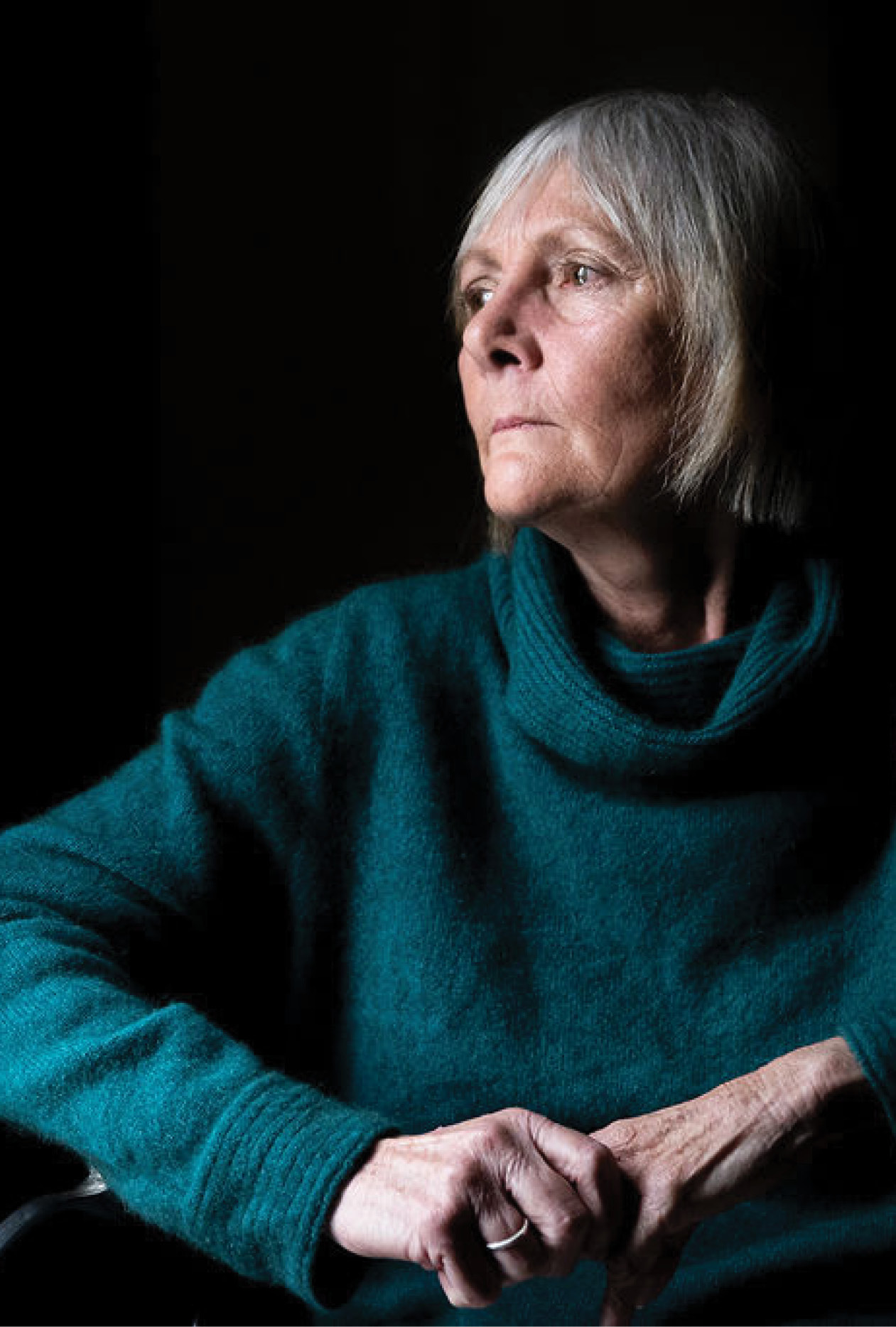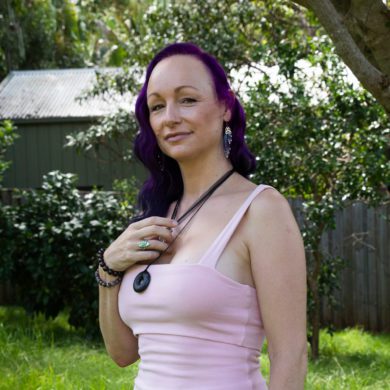The first time, it started at a birthday party in the local town hall. A bloke she’d known at school stopped to say hello; Deborah Thomson, then a shy and socially anxious 24-year-old student, chatted with him. Wayne*, her boyfriend, stormed off. When she followed him outside, he spat in her face. “If I’d left you alone there with him, he would have screwed you,” he screamed.
Deborah tried to calm him but when he kept arguing she decided to catch a taxi home. “I didn’t want to be talked to that way.” Wayne followed her home. “He took me into my bedroom and threw me around then began to strangle me. I was starting to blackout, then he smashed my head into the brick wall three times.” As she finishes her sentence, Deborah gestures to a spot on her forehead – the point of impact then and which years later would be the site of major neurosurgery.
It was the mid 1980s and Deborah was, she says now, “naive and immature”. She didn’t know anything about intimate partner violence. “None of us knew what it was.” She blamed herself for his behaviour, thought she wasn’t good enough.

The couple got married. For the next 17 years, Wayne frequently and violently abused his wife. Sometimes he threatened to get his gun and shoot her. One time he stood over Deborah with an axe; “should I use this?” he asked in a voice she remembers as being calm, almost pleasant. She begged him not to. “He must have got bored I guess and took the axe inside and locked the door and left me outside.”
Time and again, it was Deborah’s head that bore the brunt of his assaults. He would punch her in the head or push her so she fell. One day, he pushed her down the stairs and her head hit the ground. She was concussed. Another time he tackled her to the ground and her head slammed onto bitumen. “He tried to suffocate me twice, both times with his body on my face, which seriously scared me.”
Every day, she woke with a headache. Every day she took paracetamol through the day to keep going.
Now 62 and living on the north-west coast of Tasmania, Deborah is still dealing with the effects of her ex-husband’s brutality – she has high blood pressure, memory loss, migraines, has been hospitalised for mini-strokes and, in 2016, had surgery to clip two aneurysms which her surgeon attributed to the repeated assaults on her brain.
He tried to suffocate me twice, both times with his body on my face, which seriously scared me
An increasing body of scientific evidence shows repeated head trauma in contact sports, especially football, causes traumatic brain injury (TBI), including the neurodegenerative disease chronic traumatic encephalopathy (CTE).
A Senate Inquiry into the issue of brain injury in sport is due to report its findings in June. Yet TBI in survivors of domestic violence like Deborah has received minimal attention.
“I believe it’s a hidden epidemic in Australia,” says Macquarie University Hospital neurologist Dr Rowena Mobbs. “We have not had anywhere near the focus we ought to have had on this issue, not only because of the head injury per se, but because of the effects and ramifications of that psychologically, socially, occupationally.”
A 2018 study found that 40 per cent of 16,296 victim survivors of family violence (including children) attending Victorian hospitals over a 10-year period had sustained a brain injury.
“That’s extraordinary, but when you look at how few domestic and family violence related-brain injuries end up in a healthcare setting, it is the proverbial tip of the iceberg,” says Nick Rushworth, executive officer of Brain Injury Australia which led the study with Monash University injury epidemiologists for the Victorian Government.
According to Australian Institute of Health and Welfare data, 2.2 million Australians have experienced physical or sexual violence from a current or previous partner. For women in Aboriginal and Torres Strait Islander communities, the situation is even more devastating. Research published in the Medical Journal of Australia in 2008 found that First Nations women had nearly 70 times the head injury rate of other women.
It’s a hidden epidemic in Australia
Kristen Smith, research director of the Indigenous studies unit in the Melbourne School of Population and Global Health at the University of Melbourne, has spent more than a decade working in areas including the East Kimberley, Albury-Wodonga and Mildura. She has met women in their 50s who might have had 20 years of abuse with more than one perpetrator.
“They’ve had their children taken off them, a lot of them have been through all sorts of addiction problems, they’ve been in and out of rehab, some of the most horrific experiences I’ve ever heard of in my life. You’ve got just no idea some of the things that some of these women have been through. Most of them have had no sort of diagnosis, but they’ve had massive head injuries over their lifetime.”
Betty Taylor, long-time campaigner against domestic violence and the managing director of the Red Rose Foundation’s Queensland Strangulation Trauma Centre, adds another layer of horror to the story. She says non-fatal strangulation is increasingly prevalent in family violence, sometimes as a non-consensual element of sex. “People were seeing strangulation as a one-off event but when we start talking to the women who come to the centre, it’s not. Some of them cannot remember how many times they’ve been strangled,” Taylor says. “And we’ve got huge concerns about young women and strangulation linked to pornography.”
Most of these women have had no sort of diagnosis, but they’ve had massive head injuries over their lifetime
Research has found that non-fatal strangulation in a relationship is a key risk marker of escalating violence and potential death. (In the months leading up to the day in 2020 that Brisbane man Rowan Baxter burned his wife, Hannah Clarke, and their three children to death, Hannah told a social worker that he had previously put his hands around her throat.)
Non-fatal strangulation can cause hypoxic or anoxic brain injury – damage as a result of a restricted flow of oxygen to the brain, or a complete interruption of oxygen supply. Often, a woman who has been strangled has no visible signs of injury and it can be weeks or months before problems such as blood clots, stroke or brain damage become evident.
Taylor and her team spend time talking to medical staff about what they should be aware of in relation to women presenting to emergency departments.
“Just because you’re not looking at someone that’s been belted up badly and has a whole lot of visible injuries, broken bones, doesn’t mean you haven’t got someone in front of you that’s been very, very seriously injured.”
Just because you’re not looking at… visible injuries doesn’t mean you haven’t got someone that’s been very, very seriously injured
More than 30 years after her boyfriend’s serial violent abuse, Freyja*, a 64-year-old Brisbane woman, is crippled by the effects of brain injury. “I thought I was going to die,” she says, remembering the first time the man attacked her. They had been talking about a prosaic matter, a Christmas break-up at her daughter’s school that she hoped he might attend, when he suddenly thrust her up against a wall in her dining room and started to choke her.
“He put more pressure on my neck, and then just as I was falling unconscious, I realised he’d just dropped me, like drew the hand away, and I fell, fortunately on carpet,” she says.
At the school event the next day, Freyja had a seizure. She didn’t regain consciousness until she was in hospital. Over the next two years, the man’s abuse escalated. He tightened his hands around her neck on multiple occasions, including once in front of other people who did nothing to help her (she is still heartbroken that onlookers abandoned her).
One day during such an attempt she fell and split her head open on the road. She was stitched up at a medical clinic but lied about how she’d received the injury. “I didn’t tell them, I was ashamed.”
I have panic attacks, I have lucid nightmares, my major depression is really bad.
The abuse has left her with grave psychological scars – “I have panic attacks, I have lucid nightmares, my major depression is really bad” – and also debilitating physical issues. In 2001, Freyja was diagnosed with mild brain damage. She has seizures, memory loss and tremors which cause her head to shake. “That can be really embarrassing out in public, because it makes me look like I’m a junkie or an alcoholic.”
Brain injuries range in severity from concussion, which is also called mild traumatic brain injury (mTBI), through to moderate and severe traumatic brain injury. Chronic traumatic encephalopathy (CTE), once considered a boxer’s disease and known as “punch drunk syndrome”, is the result of repeated blows to the head over time and is progressive and eventually fatal. But even mTBI can have long-lasting, sometimes irreversible effects.
“We call it mild because we can’t see structural changes on a scan but very commonly it’s not mild for a person’s life,” says Dr Mobbs. “The symptoms … impact people severely.”
One of the significant factors in brain injury is that each blow or knock or impact has a cumulative effect and symptoms can emerge years after the original injuries were sustained. Accepted best practice for footballers who have sustained a concussion is that they should only return to play when they are asymptomatic – and, in the case of AFL players, only on the 12th day after the concussion was sustained. But women and children in situations of domestic and family violence don’t have that luxury.
“They often get returned to an environment with a high level of risk exposure to subsequent brain injuries in a way that for an elite sports person, simply doesn’t apply,” says Rushworth.
Dr Mobbs says that most women with domestic-violence-related brain injuries have had repeated head trauma, which might include strangulation, blows and whiplash-style injuries.
“Many go on to develop what we call a post-concussion syndrome or post-traumatic migraine”. Symptoms of each condition overlap and can include headaches, nausea and vomiting, balance problems and dizziness, fatigue, light and noise sensitivity, and concentration and memory difficulties.
Moderate and severe TBI is also linked to the onset of dementia. In 2020, a major Lancet medical journal report on dementia added three new risk factors – excessive alcohol consumption, air pollution and traumatic brain injury.
In Australia, about two-thirds of dementia sufferers are women, yet, says Nick Rushworth, few researchers either here or internationally are investigating the links between domestic and family violence and dementia. “It really frustrates the living hell out of me,” he says.
It really frustrates the living hell out of me
“Having a brain injury is just so awful,” says Talie Star, a Sydney woman who grew up in “an exceptionally violent” home and, as a child, endured strangulation and had her head pushed against a wall.
When Talie slipped on a mossy path last year and fell, slamming her head on concrete, it was a devastating setback. Before then, the brain injuries she sustained had been manageable. After the fall, she had to learn to walk again. Now, she says, it feels like she goes in and out of a fog.
“I feel like I’m almost inside my head, trying to navigate my way out. It’s exhausting. I feel like I’m constantly thinking, ‘oh, this isn’t working, how do I do this differently?’ It’s quite distressing to not have your brain working.”
Talie works as an advocate and consultant for multiple organisations including Domestic Violence NSW and is a co-founder of the Independent Collective of Survivors (ICOS). “I used to be able to read multiple documents and give feedback on multiple things,” she says. “Now I’m reading things and at times I can’t even work out what I’m reading.”
Nick Rushworth says brain injury is often referred to as an “invisible disability” – there’s usually no physical evidence of it, the injuries often fall into the mild category and people who sustain brain injuries, especially women who might fear having their children taken away, avoid seeking healthcare.
That invisibility leads to misunderstanding and stigma. Many of the victim survivors that Rushworth has worked with have been unable to return to work because their memory is so impaired or “they’re thought to be lazy or inattentive to what the boss has asked them to do”, he says.
No one understands what’s gone on for them so they’re actually getting a lot of victim-blaming around it
Similarly, Betty Taylor has observed how brain injury can affect multiple areas in a woman’s life. She says some women cause great frustration for government and non-government service staff because they are incapable of organising themselves and often forget appointments or court dates.
“They’re not fully functioning human beings, but no one understands what’s gone on for them so they’re actually getting a lot of victim-blaming around it.” For women trying to prosecute partners for the violence they have inflicted upon them, or protect their children in family court, a brain injury is one more impediment to justice.
She relates the story of a young woman with a brain injury who visited the emergency department of a large Brisbane hospital. “She presented like she was on drugs … slurred speech, she couldn’t walk properly, and because of her age they were drug testing her; she rang one of our team and said, ‘can someone please talk to them’?”
Perhaps the most intractable and wicked thing about brain injury is its cyclical, intergenerational nature. According to the Brain Injury Australia study, there are disproportionately high rates of brain injury in male perpetrators of intimate family violence.
“There can be vicious cycle of someone who’s had [a brain injury] giving one to somebody else and then the pain continues,” says Rushworth. In addition to physical symptoms, a brain injury can alter a person’s behaviour and cause disinhibition or impulsivity. They might do or say the first thing that comes into their head and are more likely to “fly off the handle”.
Through her work in Indigenous communities, Kristen Smith has learned that police frequently pick up both perpetrators and victim-survivors of domestic violence for a range of issues and jump to the conclusion that they’re drunk or on drugs. “There is really a lot of criminalisation of people with brain injury, because they haven’t been diagnosed,” Smith says.
She believes brain injury is playing a far greater role in the challenges Aboriginal communities face than anyone has previously even contemplated. “Victims are more likely to be victimised if they have brain injury, perpetrators are more likely to perpetrate if they have brain injury … and then if we bring in issues like alcohol and other drugs and how they play a role in family violence as well, it’s just quite diabolical.”
And across the board, in both Indigenous and non-Indigenous communities, there are other invisible victim-survivors of brain injury. “Children have dropped out of the conversation but Brain Injury Australia’s report did show up very, very high rates of child physical abuse, including traumatic brain injury,” says Nick Rushworth. Adds Betty Taylor: “We’re not even beginning to touch the strangulation of children.”
Victims are more likely to be victimised if they have brain injury; perpetrators are more likely to perpetrate if they have brain injury
There are no simple solutions to tackling brain injury in victim survivors of family violence. Taylor believes that support services need to work holistically and, beyond offering trauma counselling, must help women with fundamentals such as housing and court support. “If strangulation charges are going to court it’s often a protracted and trauma-inducing process and women need help with the logistics of that.”
Often, she says, women who have sustained brain injuries need “memory joggers” to help them remember appointments. “There are a lot of ways you need to work differently with them.” Similarly, Talie Star says women need to be able to access specialist financial centres. “When they put a form in front of you, and your brain is not working, you can’t read that form; I need people to go through things with me now.”
Dr Mobbs believes domestic and family violence services need to integrate with head-injury support services. “These injuries are often partly treatable,” she says. “Many people will recover, but they often need the assistance of a neurologist.”
And, she adds, it would be a major step forward if a biomarker test could be developed to identify microscopic brain injuries so the fact of a head injury can be formalised. “This would have the benefit of early diagnosis and management which might have lifelong benefits for women and their children”.
Kristen Smith laments the lack of work happening to address brain injuries in First Nations communities. “There needs to be a lot more research focusing on these issues. It’s so problematic not having a greater understanding of the levels of brain injury in populations.”

In Tasmania, Deborah Thomas is doing her best to raise awareness about the issues of brain injury and non-fatal strangulation. She has written a book about her experience, Whose Life is it Anyway? Recognising and Surviving Domestic Violence, and was involved in the campaign to get a new stand-alone criminal offence of non-fatal strangulation, choking and suffocation brought into law in Tasmania.
She gives talks to high school students about coercive control. At a school recently, a young girl came up to Deborah to say that she’d read her book and was paying attention to what was being said in the media about coercive control. The student said that, as a result of what she had learned, she had left an abusive boyfriend and now was helping a friend going through a similar experience. “I recognise abuse,” she said.
Deborah continues to live with the effects of her ex-husband’s abuse and the brain injury – among other issues, she has trouble with her right eye, which was damaged during the operation to address the aneurysms. But for 12 years she has been in a supportive relationship with “an amazing partner”. And, she says, she has a voice now. “I’m doing work that I love.”
* Some names have been changed.
1800RESPECT
1800FULLSTOP
Want more stories like this? Sign up to PRIMER’s free weekly newsletter













3 Comments